An XML sitemap is a crucial file for any website with serious search engine optimization (SEO) goals. It acts as a roadmap, listing all of your important pages to help search engines like Google discover, crawl, and index your content more efficiently. By categorizing your content, sitemaps clarify your website’s structure, which is a key factor in how search engines understand and rank your site.
While you can create a sitemap manually, a sitemap generator ‘automates this process, saving you time and reducing the risk of errors. These tools create the sitemap file for you, which you can then submit to search engines to boost your site’s visibility.
Choosing the right tool depends on your website’s platform, its size, and the level of control you need. This article reviews the 8+ best sitemap generator tools to help you find the perfect fit.
Eduma – Education WordPress Theme
We provide an amazing WordPress theme with fast and responsive designs. Let’s find out!
How to Choose the Best Sitemap Generator
Before diving into the options, consider these key factors to find the ideal sitemap generator website or software for your needs:
- Ease of Use: Is the interface intuitive? The tool should offer clear instructions and a smooth user experience, even for those without deep technical knowledge.
- Sitemap Formats: Does it support the formats you need? While XML is standard for search engines, HTML sitemaps can be useful for human visitors.
- URL Capacity: Check for limitations on the number of URLs the tool can process. Ensure it can handle your current website size and scale with your future growth.
- Customization Options: A good tool lets you customize your sitemap. You should be able to include or exclude specific pages, set crawl priorities for important content, and define update frequencies.
- Accuracy and Reporting: The generator should create error-free sitemaps. Advanced tools also offer reports, identifying crawl errors or broken links that need attention.
- Pricing: Does the tool fit your budget? Many offer excellent free versions or trials, with paid tiers providing advanced features like automatic updates and detailed audits.
8+ Top Sitemap Generator Tools: A Detailed Review
Here are 8 of the best tools available, reordered and reviewed to help you make an informed decision.
1. Yoast SEO (WordPress Plugin)

Yoast SEO is one of the most popular all-in-one SEO plugins for WordPress, currently active on millions of websites. Its sitemap functionality is a core feature. Once activated, the plugin automatically creates and maintains your XML sitemap, making it a “set-it-and-forget-it” solution for WordPress users. You simply need to submit the sitemap URL to Google Search Console once.
Key Features:
- Automatic Generation: Instantly creates a comprehensive XML sitemap upon plugin activation.
- Auto Updates: Automatically updates the sitemap whenever you add, remove, or change content on your site.
- Selective Inclusion: Allows you to include or exclude certain post types or taxonomies from your sitemap via the plugin settings.
- Seamless Integration: Functions as part of a complete SEO toolkit, handling many on-page optimization tasks.
Best For: WordPress website owners, from beginners to experts, who want an effortless way to manage XML sitemaps as part of a broader SEO strategy.
Pricing:
- Free: Includes the essential XML sitemap functionality and other core SEO features.
- Premium ($99/year): Adds advanced features like internal linking suggestions, redirect management, and AI-powered title/meta description generation.
2. Screaming Frog SEO Spider (Desktop Tool)
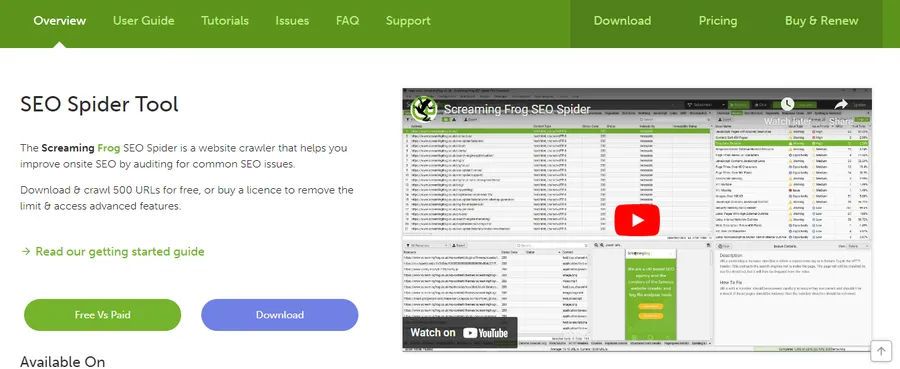
Screaming Frog is a powerful and highly respected website crawler used by SEO professionals worldwide. While its primary function is to audit technical SEO issues, it includes a robust feature to generate sitemap XML files. It crawls your site just like a search engine, providing immense detail and control.
Key Features:
- Advanced Customization: Offers complete control over which URLs are included, with options to set priority, frequency, and include images.
- Large Website Support: Capable of crawling massive websites to create comprehensive sitemaps.
- Technical Audit: Identifies broken links, server errors, and duplicate content that you can fix before generating your sitemap.
- Robots.txt Integration: Respects robots.txt directives, noindex tags, and canonicals for an accurate sitemap.
Best For: SEO professionals, agencies, and owners of large, complex websites who need granular control and in-depth technical analysis.
Pricing:
- Free: Crawl limit of 500 URLs with basic features.
- Paid ($259/year per license): Unlimited URL crawling and unlocks advanced features like scheduling, JavaScript rendering, and Google Analytics integration.
3. XML-Sitemaps.com (Web Tool)
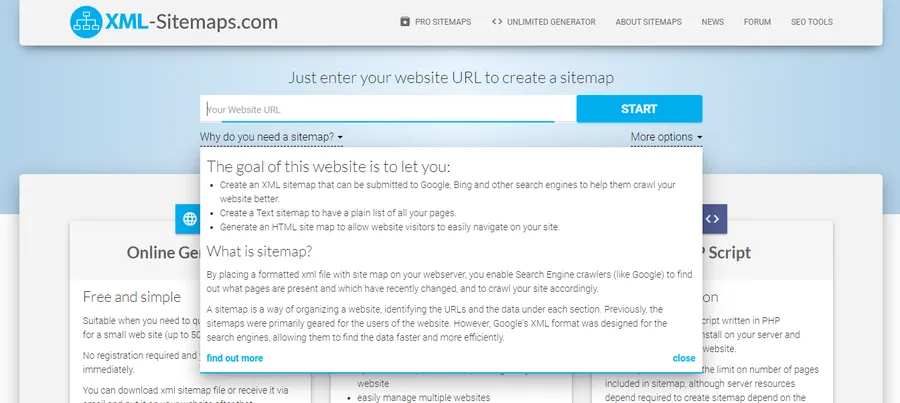
XML-Sitemaps.com is a straightforward and highly accessible online generator sitemap tool. Its simplicity makes it an excellent starting point for beginners or for those with smaller websites. You enter your website’s URL, and it crawls your site to produce a sitemap file ready for download.
Key Features:
- Multiple Formats: Allows you to download sitemaps in various formats, including XML, GZ, HTML, and TXT.
- User-Friendly: The interface is extremely intuitive, requiring no technical setup.
- Automatic Updates (Paid): The Pro version can automatically recrawl your site and update the sitemap on a schedule.
- Broken Link Detection (Paid): Paid plans can scan your site for broken links and provide a report.
Best For: Beginners, small business owners, and anyone needing to quickly generate sitemap files without installing software or plugins.
Pricing:
- Free: For websites with up to 500 pages.
- Pro (Starts at $5.99/month): Supports larger sites (up to 2 million pages), offers automatic updates, image/video sitemaps, and detailed reports.
4. Rank Math (WordPress Plugin)
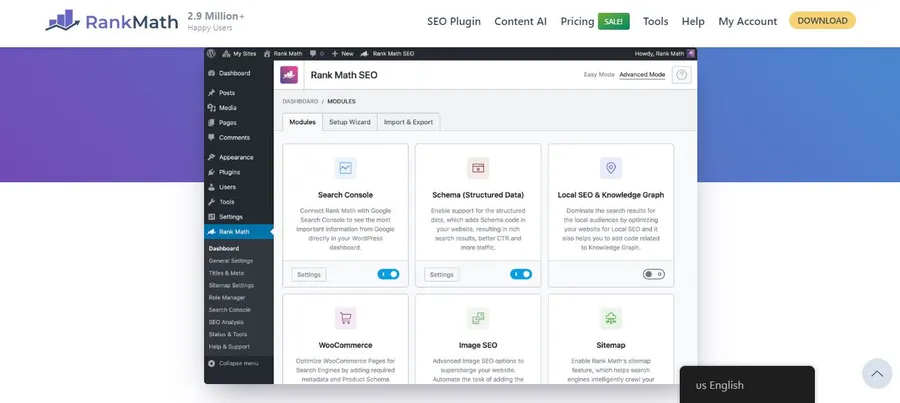
Rank Math is a fast-growing, feature-rich SEO plugin for WordPress and a direct competitor to Yoast. It offers an impressive suite of tools in its free version, including a highly configurable sitemap generator. After a quick setup wizard, Rank Math automatically handles sitemap creation and updates. You can refer to this article to understand more about Rank Math vs Yoast SEO.
Key Features:
- Granular Control: Provides detailed options to include or exclude post types, taxonomies, and even individual posts/pages.
- Specialized Sitemaps: Can generate sitemap files for news and video content, which is beneficial for specific niches (paid feature).
- Automatic Generation & Submission: Creates, updates, and notifies search engines about your sitemap automatically.
- Lightweight Code: Designed to be fast and efficient, with a minimal impact on site performance.
Best For: WordPress users who want more advanced features and customization options in a free SEO plugin.
Pricing:
- Free: Offers robust sitemap functionality and a wide array of SEO tools.
- Pro (Starts at $5.75/month): Unlocks advanced schema, news/video sitemaps, and support for unlimited personal websites.
5. Sitebulb (Desktop Tool)
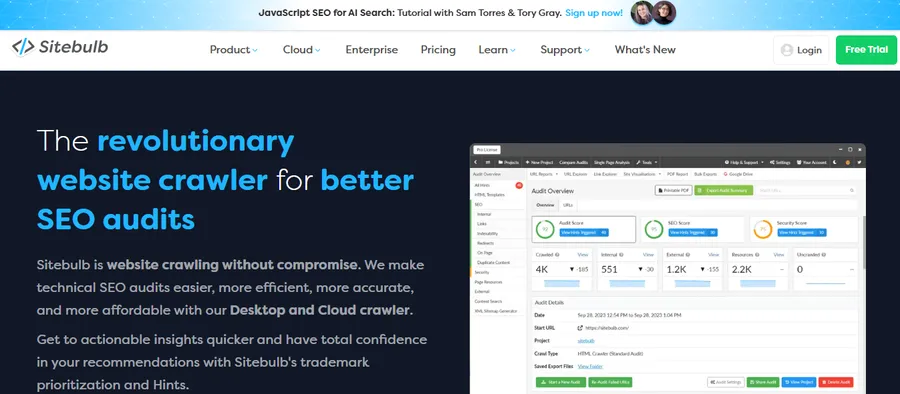
Sitebulb is a desktop website crawler that combines powerful auditing capabilities with a user-friendly interface and visual reports. It’s an excellent alternative to Screaming Frog, particularly for those who appreciate actionable recommendations. Its sitemap generator is highly configurable and integrated with its audit features.
Key Features:
- Integrated Sitemap Audit: Audits existing sitemaps to find orphan URLs (pages not linked internally), non-indexable pages, and other issues.
- Highly Configurable Generation: Allows you to build XML sitemaps from multiple crawl sources (e.g., website crawl, Google Analytics) and customize priority and frequency settings.
- Actionable Reports: Provides clear, prioritized hints on how to improve your website’s technical SEO and sitemap health.
Best For: SEO professionals and agencies who want a powerful desktop crawler with insightful, easy-to-understand reports and advanced sitemap auditing.
Pricing:
- Lite ($13.50/month): For smaller projects up to 10,000 URLs.
- Pro ($35/month): For larger sites up to 500,000 URLs. A 14-day free trial is available.
6. Slickplan.com (Web Tool)

Slickplan is primarily a visual sitemap builder and website planning tool designed for collaboration. It helps teams design site architecture, plan content, and create user flows. While its focus is on visual planning, it includes an XML sitemap generator to export the structure you build.
Key Features:
- Visual Sitemap Builder: Use a drag-and-drop interface to create visually appealing diagrams of your site structure.
- Collaboration Tools: Invite team members to collaborate on planning and content creation within the platform.
- Multiple Export Options: Download your sitemap as an XML file, or as a PDF, image, or HTML file for presentations.
- XML Validator: Includes a tool to check your generated XML file for errors before submission.
Best For: Web designers, UX professionals, and marketing teams who need to collaborate on website architecture planning.
Pricing:
- Free: A very limited free generator is available.
- Paid Plans (Start at $11.99/month): Unlock full features, project saving, collaboration, and advanced tools. A 14-day free trial is offered.
7. Octopus.do (Web Tool)
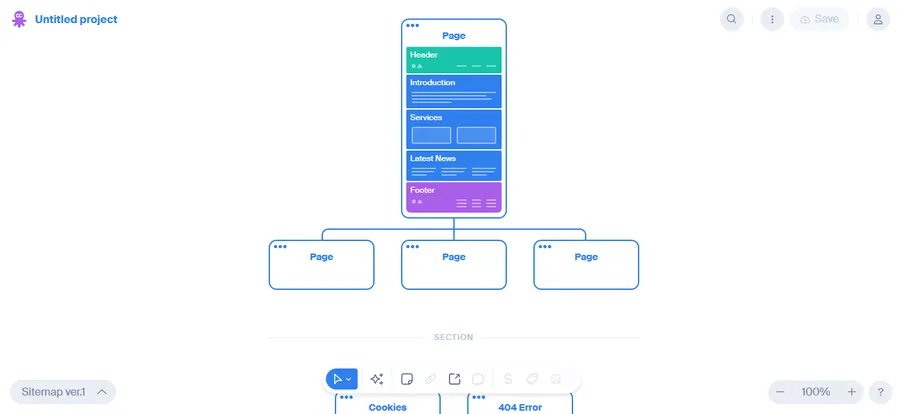
Similar to Slickplan, Octopus.do is a visual sitemap generator website focused on rapid prototyping and website structure planning. It allows you to quickly build a visual representation of your site, organize content, and then export it in various formats, including XML.
Key Features:
- Fast Visual Builder: A clean, simple drag-and-drop interface for quickly mapping out a website structure.
- Content Planning: Add content blocks and notes directly to each page in your visual map.
- Multiple Export Formats: Export your sitemap as XML, PNG, PDF, or CSV.
- Collaboration: Share your visual sitemap with team members and clients for feedback and editing.
Best For: Project managers, content strategists, and freelancers who need a fast, simple tool for visualizing and planning website structures.
Pricing:
- Free: Manage 1 project with unlimited pages per sitemap.
- Pro ($12/month): Manage up to 8 projects with a larger crawl limit.
- Team ($16/month): Unlimited projects and team members.
8. XML Sitemap Generator for Google (WordPress Plugin)
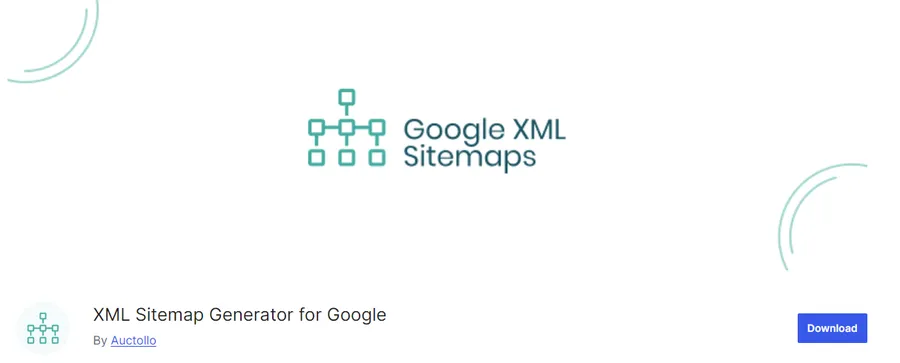
XML Sitemap Generator for Google does one thing and does it exceptionally well: it creates a comprehensive XML sitemap for your WordPress site. Unlike all-in-one SEO suites, this tool is dedicated solely to sitemap generation, offering advanced options without the extra features of a full SEO plugin.
Key Features:
- Dedicated Functionality: Focuses exclusively on creating highly effective sitemaps.
- Broad Compatibility: Supports all types of WordPress-generated pages and custom URLs.
- Automatic Notifications: Automatically notifies all major search engines every time you create a post.
- Simplicity: Despite its advanced options, it’s easy to configure and requires no technical skill to operate.
Best For: WordPress users who are happy with their current SEO setup but need a dedicated and powerful plugin just to generate sitemap files.
Pricing:
- Free: The plugin is completely free to use.
FAQs About The Best Sitemap Generator
1. What is an XML sitemap and why do I need one?
An XML sitemap is a file that lists the essential pages of your website, making it easier for search engines to find and index your content. It's particularly important for large websites, new websites with few external links, or sites with rich media content.
2. Can I create a sitemap without a generator tool?
Yes, you can create a sitemap manually by writing the XML code yourself. However, this is time-consuming and prone to syntax errors. A sitemap generator automates this process, ensuring your sitemap is properly formatted and up-to-date.
3. How many URLs can be in one sitemap?
A single XML sitemap file is limited to 50,000 URLs and must be no larger than 50MB (uncompressed). For larger sites, you can create a sitemap index file, which is a sitemap that lists other sitemaps. Most generator tools handle this automatically.
4. How often should I update my sitemap?
You should update your sitemap whenever you make significant changes to your site, such as adding a new page, updating key content, or removing a page. Most WordPress plugins and premium generator tools automate this process.
5. After I generate a sitemap file, what's the next step?
Once you have your sitemap's URL, you should submit it to search engines through their webmaster tools. For Google, this is done via Google Search Console. For Bing, you use Bing Webmaster Tools. This tells them where to find the file so they can begin using it to crawl your site.
Choosing the Right Tool for the Job
Selecting the right sitemap generator is a key step in building a solid technical SEO foundation. Your choice should align with your platform, technical comfort level, and website goals.
To simplify your decision:
- For most WordPress users: Yoast SEO provides an easy, integrated solution.
- For SEO professionals: Screaming Frog offers unparalleled control and auditing power.
- For a quick, free online tool: XML-Sitemaps.com is a perfect starting point.
By using the right tool, you can ensure search engines can efficiently navigate your site, leading to better indexing and improved visibility in search results.
Read more:
7+ Best SEO Audit Tools for Your Website
17 Must-Have WordPress Plugins That Every Website Needs
13+ Best Free HTML Sitemap Generators
Contact US | ThimPress:
Website: https://thimpress.com/
Fanpage: https://www.facebook.com/ThimPress
YouTube: https://www.youtube.com/c/ThimPressDesign
Twitter (X): https://twitter.com/thimpress


